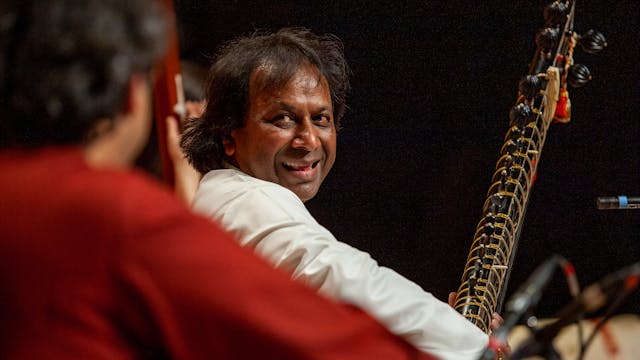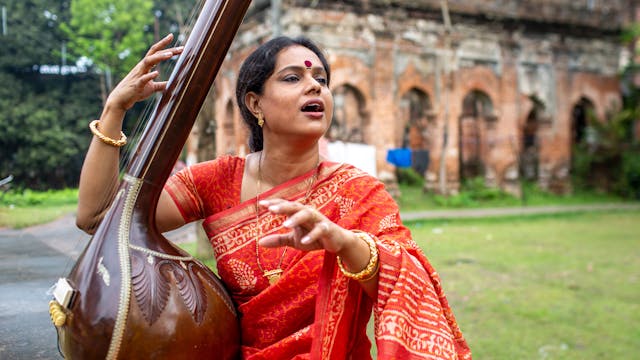Pandit Ulhas Kashalkar | Raag Bhairavi
Thumri and light classical
•
14m
Recorded at Darbar Festival 2011, on 24th April, at King's Place, London.
Musicians:
- Pandit Ulhas Kashalkar (khayal)
- Pandit Suresh Talwalkar (tabla)
- Sameehan Kashalkar (supporting vocals)
- Chinmay Kolhatkar (harmonium)
- Priya Prakash (tanpura)
Raag Bhairavi; Thaat: Bhairavi; Samay: Morning
‘Tum Ho Jagat Ke Data,’ (O’ Almighty, you are the creator of the universe) is a beautiful thumri that was composed by the late sitar legend, Ustad Vilayat Khan. It is set to Raag Bhairavi in a slow tempo of 7 beats (Rupak taal). Unlike most Bhairavi compositions which have a faster tempo and are sung at the end of a concert, this one stands different. Ustad Khan had structured the heart-wrenching emotions of Bhairavi with befitting devotional lyrics in an unhurried pace that brings out the essence of the raga in a much more condensed form.
During the 90’s, Pandit Ulhas Kashalkar had developed a refreshing style to his khayal presentations by polishing his skills under Ustad Khan. One of the most respected and leading vocal exponents, he was always enchanted by the magic of Ustad Vilayat Khan’s music and wanted to push his frontiers and develop a new approach to his khayal singing.
In the process, he ended up learning many of the sitar legend’s compositions which then became a regular feature of his live concerts thereafter.
In this thumri, he paints the vignettes of Raag Bhairavi beautifully, standing true to the accolade of the best Bhairavi performer as given to him by Ustad Vilayat Khan. Pandit Suresh Talwalkar puts his lyrical imprint on this soft, devotional number with a very sensitive accompaniment on the tabla. Sameehan Kashalkar, his son and disciple, gives a commendable backing on the vocals revealing his own talent. Chinmay Kolhatkar gives invaluable support to this grand finale of a memorable concert.
Bhairavi is often described as the ‘queen of ragas’. It takes its name from the Hindu goddess of destruction and conjures versatile moods. To some, it can evoke awe, terror and chaos; To others, ‘a pleasant, sobering atmosphere of love and piety’. Though usually heard as the final piece in a concert, its natural home is the sunrise hour. Understanding the raga is crucial to broader Hindustani musical learning which is why, Pandit Hariprasad Chaurasia believes that Bhairavi should be practiced till a musician breathes his last. Bhairavi is a sampurna raga – the dominant note is Ma or 4th and the sub-dominant is Sa (1st). It uses all the 7 notes with Re, Ga, Dha and Ni as komal (2nd, 3rd, 6th, 7th as flat), but one is also allowed to apply the pure version of all these notes that enables a rare chromatic structure to emerge in a Hindustani raga.
Up Next in Thumri and light classical
-
Ustad Shahid Parvez | Bhairavi
Recorded at Darbar Festival 2007, on 15th April, at the Phoenix Theatre Leicester.
Musicians:
- Ustad Shahid Parvez (sitar)
- Pandit Yogesh Samsi (tabla)
- Debipriya Das (tanpura)Raag Bhairavi; Thaat: Bhairavi; Samay: Morning
Parvez’s portrayal of Bhairavi is deeply profound; In this piece fr...
-
Arati Ankalikar Tikekar | Chaiti
Recorded at Darbar Festival 2011, on 23rd April, at King's Place, London.
Musicians:
- Arati Ankalikar (khayal vocal)
- Anubrata Chatterjee (tabla)
- Chinmay Kolhatkar (harmonium)
- Omkar Dalvi (pakhawaj)
- Priya Prakash (tanpura)
- Shobhana Patel (tanpura)Song: Chait Maas Bolele Koyeliya ...
-
Indrani Mukherjee | Raag Multani
Recorded on location in Bawali, West Bengal, India.
Musicians:
- Indrani Muckerjee (vocal)Raag Multani; Thaat: Todi; Samay: Afternoon
Indrani Mukherjee holds the tradition of the Kirana-Rampur gharana and thumri in Purab Ang. Mukherjee performs Raag Multani in the afternoon on location in the...



